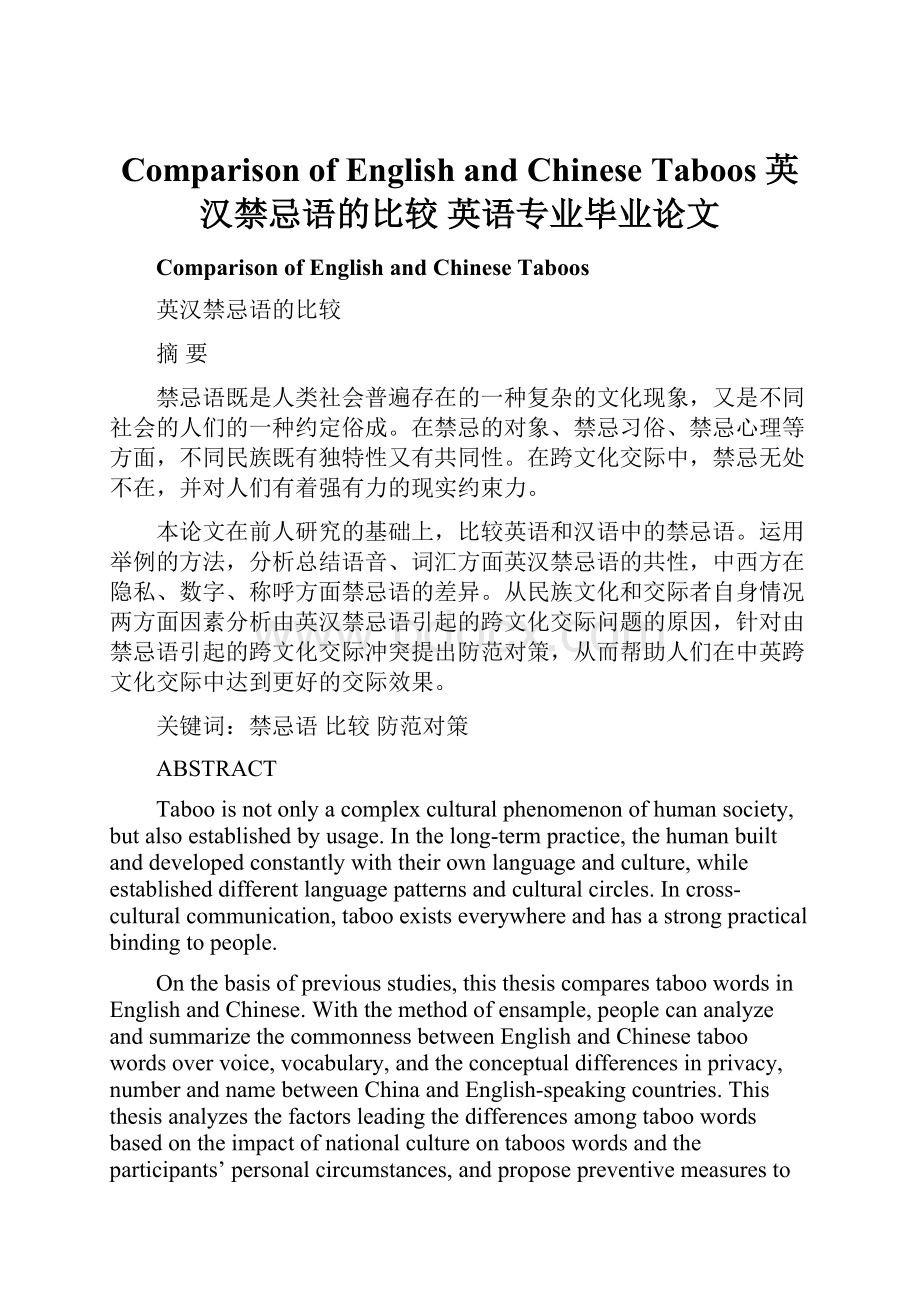Comparison of English and Chinese Taboos 英汉禁忌语的比较英语专业毕业论文.docx
《Comparison of English and Chinese Taboos 英汉禁忌语的比较英语专业毕业论文.docx》由会员分享,可在线阅读,更多相关《Comparison of English and Chinese Taboos 英汉禁忌语的比较英语专业毕业论文.docx(25页珍藏版)》请在冰豆网上搜索。

ComparisonofEnglishandChineseTaboos英汉禁忌语的比较英语专业毕业论文
ComparisonofEnglishandChineseTaboos
英汉禁忌语的比较
摘要
禁忌语既是人类社会普遍存在的一种复杂的文化现象,又是不同社会的人们的一种约定俗成。
在禁忌的对象、禁忌习俗、禁忌心理等方面,不同民族既有独特性又有共同性。
在跨文化交际中,禁忌无处不在,并对人们有着强有力的现实约束力。
本论文在前人研究的基础上,比较英语和汉语中的禁忌语。
运用举例的方法,分析总结语音、词汇方面英汉禁忌语的共性,中西方在隐私、数字、称呼方面禁忌语的差异。
从民族文化和交际者自身情况两方面因素分析由英汉禁忌语引起的跨文化交际问题的原因,针对由禁忌语引起的跨文化交际冲突提出防范对策,从而帮助人们在中英跨文化交际中达到更好的交际效果。
关键词:
禁忌语比较防范对策
ABSTRACT
Tabooisnotonlyacomplexculturalphenomenonofhumansociety,butalsoestablishedbyusage.Inthelong-termpractice,thehumanbuiltanddevelopedconstantlywiththeirownlanguageandculture,whileestablisheddifferentlanguagepatternsandculturalcircles.Incross-culturalcommunication,tabooexistseverywhereandhasastrongpracticalbindingtopeople.
Onthebasisofpreviousstudies,thisthesiscomparestaboowordsinEnglishandChinese.Withthemethodofensample,peoplecananalyzeandsummarizethecommonnessbetweenEnglishandChinesetaboowordsovervoice,vocabulary,andtheconceptualdifferencesinprivacy,numberandnamebetweenChinaandEnglish-speakingcountries.Thisthesisanalyzesthefactorsleadingthedifferencesamongtaboowordsbasedontheimpactofnationalcultureontabooswordsandtheparticipants’personalcircumstances,andproposepreventivemeasurestosolvetheconflictscausedbytaboowordsininterculturalcommunication.Thusthecommunicationincross-culturecommunicationcanachievehigherlevel.
KEYWORDS:
taboowordscomparisonpreventivestrategy
CONTENTS
Acknowledgements-------------------------------------------------------------------------------
Abstract(Chinese)----------------------------------------------------------------------------
Abstract(English)---------------------------------------------------------------------------
1.Introduction------------------------------------------------------------------------------------1
2.AspectsofTaboos----------------------------------------------------------------------3
2.1OriginandHistory-----------------------------------------------------------------------3
2.2Performance-------------------------------------------------------------------------------4
2.2.1Appellation---------------------------------------------------------------------------4
2.2.2QuestionWords----------------------------------------------------------------------4
2.2.3SensitiveTopics----------------------------------------------------------------------5
2.2.4Obscene,ProfaneandAbusiveWords--------------------------------------------5
2.3PragmaticFeaturesofTaboosinInterculturalCommunication--------------------6
2.3.1Universality--------------------------------------------------------------------------6
2.3.2Transmutability----------------------------------------------------------------------6
2.3.3Nationality----------------------------------------------------------------------------7
2.3.4Succession----------------------------------------------------------------------------7
2.3.5ClassCharacter----------------------------------------------------------------------7
2.3.6Circumbendibus---------------------------------------------------------------------8
3.TheSimilaritiesbetweenChineseandEnglishTabooWords---------------------------8
3.1InPronunciation--------------------------------------------------------------------------8
3.2InVocabulary-----------------------------------------------------------------------------9
3.2.1Death---------------------------------------------------------------------------------9
3.2.2Toilet---------------------------------------------------------------------------------9
3.2.3Curse---------------------------------------------------------------------------------9
3.2.4DiseaseandDisability-------------------------------------------------------------9
3.2.5Sexism-------------------------------------------------------------------------------10
4.TheDifferencesbetweenChineseandEnglishTabooWords-------------------------10
4.1InPrivacy--------------------------------------------------------------------------------10
4.2InNumbers------------------------------------------------------------------------------11
4.3InNames----------------------------------------------------------------------------------11
5.ReasonstoCauseConflict------------------------------------------------------------------11
5.1TheImpactofNationalCultureonTabooWords----------------------------------12
5.2TheImpactofParticipants’PersonalCircumstances------------------------------14
5.2.1Age---------------------------------------------------------------------------------14
5.2.2Sex---------------------------------------------------------------------------------14
5.2.3CulturalTraining-------------------------------------------------------------------14
5.2.4RelationshipbetweenCommunicators----------------------------------15
5.2.5Occasions---------------------------------------------------------------------------15
5.2.6SocialFactors---------------------------------------------------------------------15
6.TheSolutionstoAvoidConflicts----------------------------------------------------------15
6.1Avoidance--------------------------------------------------------------------------------17
6.2Euphemism------------------------------------------------------------------------------17
6.3HidingTruth-----------------------------------------------------------------------------18
6.4Neutral------------------------------------------------------------------------------------18
7.Conclusion---------------------------------------------------------------------------------19
7.1Summary---------------------------------------------------------------------------------19
7.2SuggestionsforFurtherResearch----------------------------------------------------20
Bibliography-------------------------------------------------------------------------------------21
1.Introduction
Languageisasocialphenomenon,whichdeterminesthatlanguagesystemisnotaclosedsystem,butlinkedinextricablywithothers.Chomskyoncesaid“People'slanguageisalwaysaffectedbyvariousformsofsocialandculturalfactors.Whenwestudythelanguage,itisofsomepeoplethatmightbecalledhumannatureofthings,thatthepsychologicalcharacteristicswithhumans,asfarasweknow,thesefeaturesareuniquetohumans.”Obviously,languageistheembodimentofhumannature.Itreflectsacultureandthemodeofthinking.Asweallknow,cultureisthesumofbeliefs,habits,livingpatternsandbehaviorsfordifferentnationalities.Differentnationshavedifferentculturalbackgrounds,whichinfluencethedevelopmentoftheirlanguage.Asthecarrierofculture,alanguagealsoshowsthespecificcharactertoitsnation.Meanwhile,languageisatoolforhuman’sthoughtandcommunication.Thougharbitraryisthenatureoflanguage,whencertainwordshavebeenmentioned,certainscenewillpresentinpeople'seyesandcausepsychologicalreactions.Asaresult,peopleexpecttoavoidorindirectreferencetheunhappywords.Thisisthephenomenonoftaboolanguage.Forforeignlanguagelearners,learningaforeignlanguageisnotonlytolearnthelanguage,butalsotounderstanditsculture.Itisthecombinationofgoingthroughcomplexpsychologicalprocessesandexploringwaysofthinkingandpsychologicalcharacteristicsunderdifferentculturalbackground.
Inthepasttwodecades,withtheprocessofhumanglobalizationandinformation,peopleindifferentregionswithdifferentculturalbackgroundscommunicatedwitheachothermoreandmorefrequently.Cross-culturalcommunicationhasbecomeanimportantfeaturetotheworld.Inhuman’slifetime,theyreceiveorsendinformationallthetime.Verballanguagebecomesthemostimportantformofcommunication.However,incross-culturalcommunication,lackingtheknowledgeofforeignlanguageandtheunderstandingofaliencultureoftenleadthefailureanderrors.Forexample,makingacirclewiththethumbandforefingerandstraighteningtheotherthreefingersrepresent“Victory”intheUnitedStates,“Insulting”inBraziland“Money”inJapan.Ifpeopleonlyknowitsmeaningas“Victory”,itwillbringpuzzleandmisunderstandingtoJapanesepeopleandBrazilians.
Clearly,culturaldiscrepancyofcommunicatorshasseriouslyaffectedcommunication,andisanimportantfeaturewhichcausesthefailureofcross-culturalcommunication.Tabooisoneofthemostimportantfactorsleadingcultureconflict.Therefore,thestudyoftaboosisanimportanttheoreticalandpracticalissueinthestudyofcross-culturalpragmatic.Though,thestudyoftaboosoninterculturalcommunicationhasimportanttheoreticalsignificanceandvalueinthestudiesofcontemporarylinguistics.Theacademiadoesnotpayenoughattentiontothissubject.
Somewesternscholarsbegantofocusonrelevanttopicsfromthe50thinthe19thcentury.Then,thestudygraduallyexpandedallaroundtheworld.Fromthecontentsviewofcross-culturalcommunicationstudy,mainlyrelatedto:
theCulturalDifferencesofSpeechCommunicationandtheDifferencesofNon-verbalCommunication.Theemphasisofresearchesbiasedtowardexperienceandpractice.Thesubstanceisextensive,butthesystemisbulky.Inbrief,thestudywentaccordingtolinguistics-strictsystemwithnarrowcontent.Studiesofcross-culturalpragmaticsstartedrelativelylateinourcountry.HeDaokuanandHuWenshiaretheearliestscholarsofthisfieldathome.Togetherwithotherscholarspromoting,thedevelopmentofthisfieldandplaysanactiveroleinthisarea.However,therearestillproblemsonthissubjectindomesticresearch.Someresearchestalkedingeneralities.Lackin